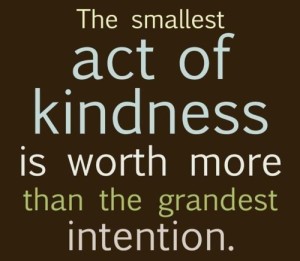A cursory look at the behavior of many leaders in politics, business, athletics, and entertainment could conclude that the best way to succeed is to be a bully! Media coverage of these leaders often includes a reflection of styles that can be considered, at best, bombastic, rude, unkind, and discourteous. A conclusion, therefore, might be supportive of the quote famously attributed to the late Leo Durocher (former manager of the baseball Brooklyn Dodgers) that “Nice guys finish last”.
As a parent, grandparent, businessperson and concerned citizen, I find this both discouraging and inaccurate. I contend that “Nice guys CAN finish first” and, in fact, can sustain that first-place position longer! Additionally, since conducting research some years ago for my book, The Kindness Revolution (2006, New York, NY, AMACOM), I have written and reported on numerous companies who succeed as a result of a leadership culture based on kindness.
For the sake of this article, let’s begin with a few definitions and assumptions.
We will define “nice” for this article as the equivalent of kind. It is important to note that most definitions of the terms clearly differentiate the two. One of the key characteristics of “kindness” is the habit of taking other people’s feelings into consideration. However, for this article, we will define them as equal and the same.
If we go further, and define “unkind”, then we will include behavior that does not take the other person’s feeling in consideration, i.e. inconsiderate.
Given the choices, then, a reasonable question would be “Why would someone choose to be inconsiderate of others?” Doesn’t this seem obvious?
History is ripe with stories of leaders who displayed “tough guy” traits of behavior; strong language, insults to others (i.e. subordinates or competitors), physical confrontation, and a lot of noise! Often times, these same stories end with the ultimate collapse of the tough guy, resulting in delight from these same subordinates and competitors, best described by the German word schadenfreude, which is the pleasure derived by the misfortunes of others.
This “tough guy” behavior can be traced to a number of sources. In some cases, it is a result of upbringing…a parental role model who has taught that brash, arrogant, strong behavior leads to best results. In other cases, it is the behavior of a coach, athlete, or military leader who is being emulated. It can even be a fictional person, such a movie character, which is the model. Whatever, the source, it appears that in most cases, the desire of the behavior is the position of power that is obtained.
The fact that is too often overlooked, however, is that in many cases, the “tough guy bully” hasn’t used the bully behavior to get to the top. He is already there! He is a member of the lucky sperm club (i.e. born on third base but thinking they hit a triple), or a great athlete handed the coaching job.
It really doesn’t take any skill to be tough when you are more powerful, bigger, or at the top of others. It takes absolutely no talent or knowledge for the rich to bully the poor, or for the coach to push around the athlete, or for the officer to rough up the enlisted man. For the manager to bully the subordinate is not a trait of leadership, but rather a RESULT of being in a leadership position.
So how does the “nice guy (or gal)” get to the top and stay there?
Perhaps by remembering the following:
The number of studies that indicate that trust is an invaluable trait of an effective leader, and that trust is a direct bi-product of respect. When respect to others is shared, it tends to draw respect.
That kindness should not be confused with weakness. Kind people can be decisive, strong, assertive, and firm. They simply choose to behave with dignity and grace as opposed to abrasiveness and aggressiveness.
That The Law of Attraction is a powerful force in leadership. Simply stated, kind and respectful individuals (and organizations, for that matter) tend to attract kind and respectful employees. Similarly, gruff and aggressive individuals and organizations will tend to attract similar behavioral styles.
That individuals who lead with compassion and kindness will retain employees and followers longer than those who lead with negativity and impoliteness.
Take a second and ask yourself…who would YOU rather follow in a difficult time during stress or conflict… the leader who is going to tell you how to get things done, harass you as it’s being done, and then take the credit for the success (or give the blame for the failure), or the leader who stays calm, encourages work with a team culture, and shares the success or takes fault for the blame. Do you want someone who is anxious and insulting, impatient and loud, or would you prefer a calming, listening, and compromising person at the top?
You know the answer…..



